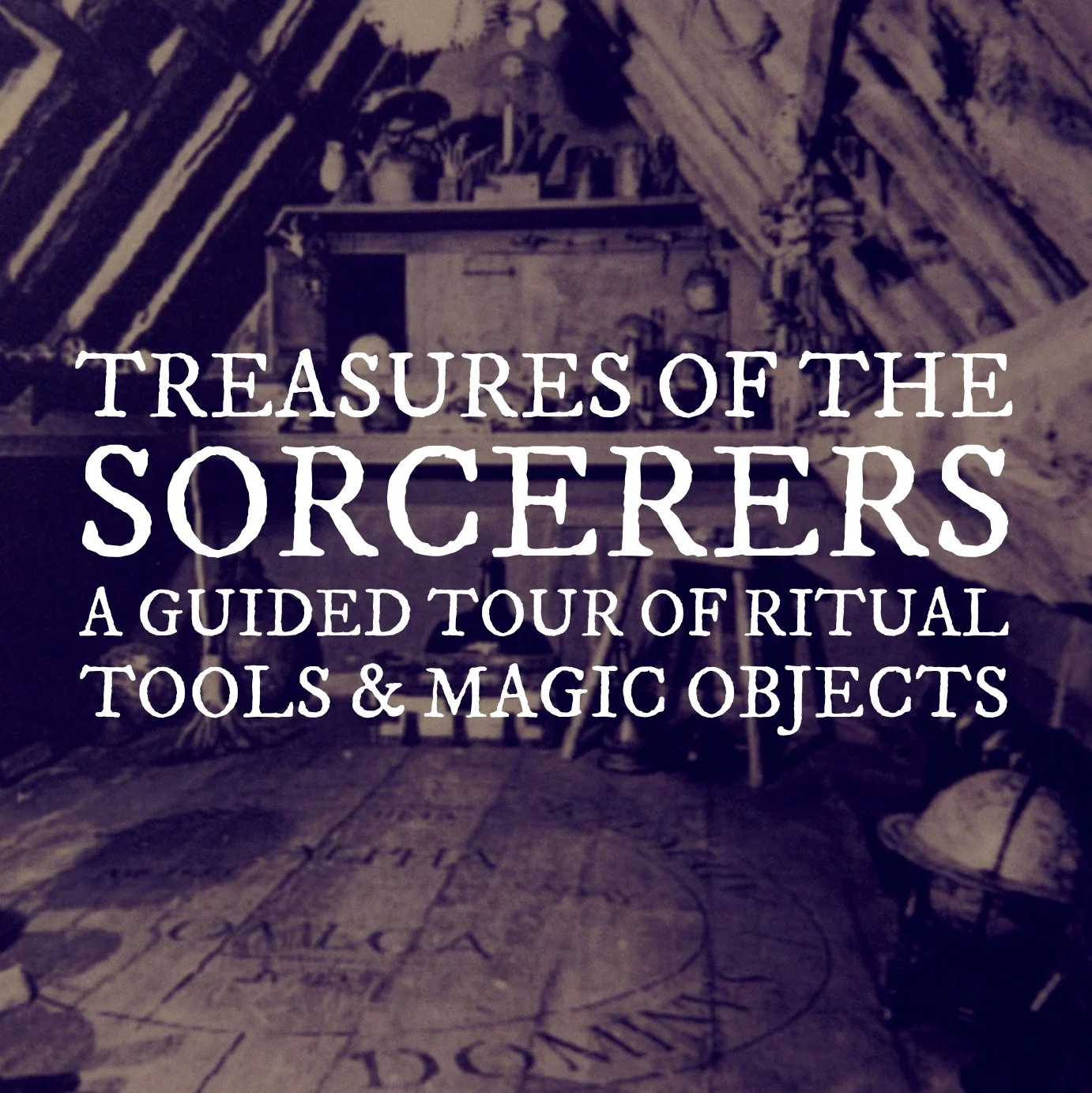Treasures of the Sorcerers: A Guided Tour of Ritual Tools & Magic Objects Course Series
Treasures of the Sorcerers: A Guided Tour of Ritual Tools & Magic Objects Course Series
A five-part course series exploring the grimoiric and folkloric magic of five forms of magical items: Wands, Blades, Shewstones, Garments, and Rings. This series consists of five two-hour long class recordings, the accompanying illustrated slide-decks, and a bibliography for further recommended study.
The arsenals of historical magicians include a vast array of magical tools, enchanted objects, cunning devices, and sorcerous implements. Such instruments of ritual and folk magic could require careful preparations by particular timings and rites of consecration, and could even require certain specified ways of storing and re-charging as well as wielding them.
Such magical objects include the ubiquitous magic wands, scepters of conjuration, and wizards staffs that grant authority, discharge spells, and command spirits; the range of ritual knives, swords, athames, and bolines that demarcate magic circles, protect the practitioner, and prepare ingredients; the scrying stones, crystal balls, and magic mirrors by which seers conjure visions and tutelary entities; not to mention the very robes, sorcerous apparel, and magical attire – from headwear to footwear – worn when performing magical operations; and even the magic rings that house and harness the powers of the stars and spirits, empower the wearer, and cast illusions.
In this five-part course, contemporary cunning-man and historian of magic Dr Alexander Cummins leads students through a guided tour of these types of ritual tools and magical objects – Wands, Blades, Shewstones, Garments, and Rings – exploring sorcerous techniques of preparation, consecration, and utility for these enchanted and enchanting implements, as well as the cosmologies, intentions, and operations of their makers and users.
Along the way we’ll make contextual comparisons between historical ritual tools and ideas about the mythological items and mythic artefacts which partly informed them: from fairy cloaks of invisibility and the conjuring ring of King Solomon, to the caduceus of Mercury and the rod of Asclepius; and many many more beyond. Through this examination and celebration of magical manufacture of these material forms of sorcerous efficacy and expertise, we’ll refine our own understandings and engagements with sorcerous instruments and experiments.
The five sessions that make up this course series break down as follows:
Wands
In the first session of this series, we discuss wands in their many forms and functions, including staffs, rods, and batons, and even extending this survey to the scepters and maces of certain forms of formal conjuration. Through this focus, we consider the folklore of the trees from which such wands were fashioned, as well as how such implements were enchanted, flourished, and how exactly they can be employed in our magics.
Blades
In our second session, we explore the variety of magical swords, knives, and scimitars, as well as the athames and bolines of various forms of ritual magic and witchcraft. In examining these bladed magical weapons, we consider various perspectives on magical power, authority, violence, and the importance of setting boundaries in our sorcery.
Shewstones
In our third session, we take stock of the wide range of implements and media of visionary divination and evocatory scrying – such as crystal balls, “black mirrors”, polished stones, and even bowls of water – to consider the magical operations of vision-at-a-distance, spontaneous wisdom, channeled magical texts and revelations, as well as conjuring spirits into reflective objects to impart knowledge and receive orders to work.
Garments
In our fourth and penultimate session, we survey ritual attire and enchanted clothing; from conjuring robes to apparel created for particular effects such as magical cloaks, garters, and more. We also include wider discussion of the range of often religiously-significant vestments discussed in the grimoires and working-books of conjurors and spiritworkers: from crowns and mitres, to stoles, albs, and phylacteries.
Rings
In our fifth and final session, we appraise traditions and examples of magical rings: from the infamous and ritually-authoritative ring of King Solomon to many instances of wearable precious and semi-precious stones and other materia for various protections, empowerments, and spell-craft. Along the way we discuss occult lapidary lore concerning the magical use of stones and minerals, as well as how the virtues of the stars and spirits were imbued and deployed through them.
By purchasing this class, you agree that you understand that no part of the material dictated or provided throughout the duration of the course may be reproduced, distributed, or used in any other form (neither electronic nor mechanic, including photocopies and recordings), without the direct and written consent of the instructor, Dr Alexander Cummins.
